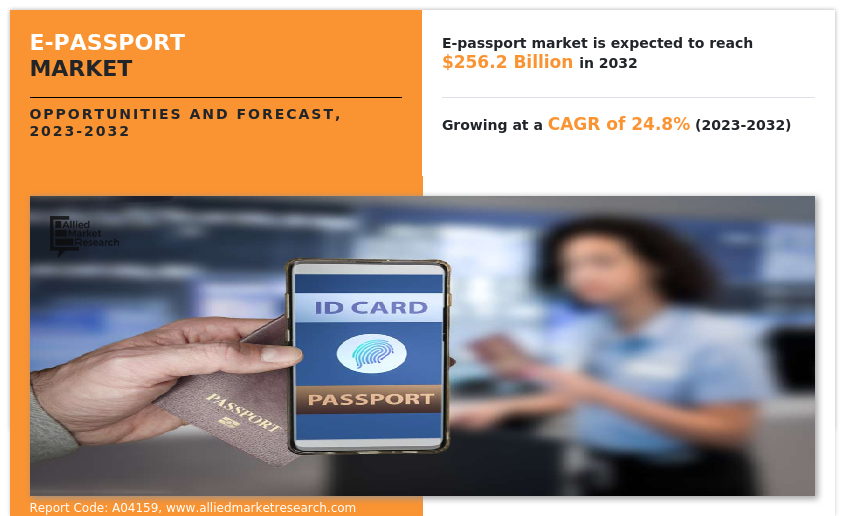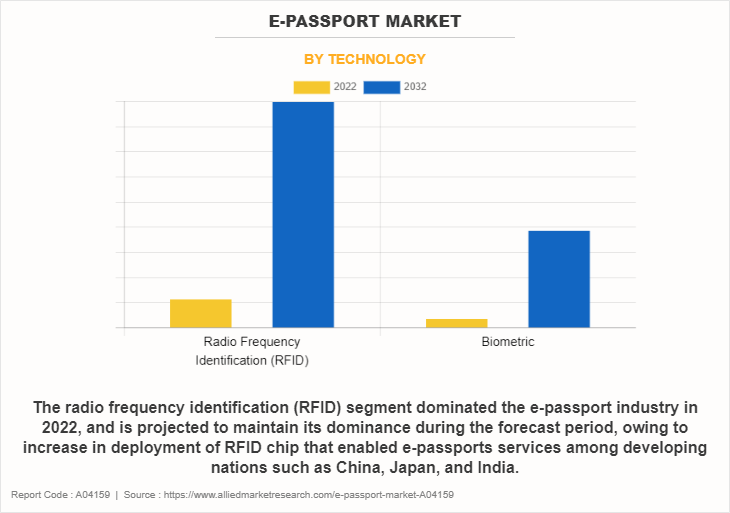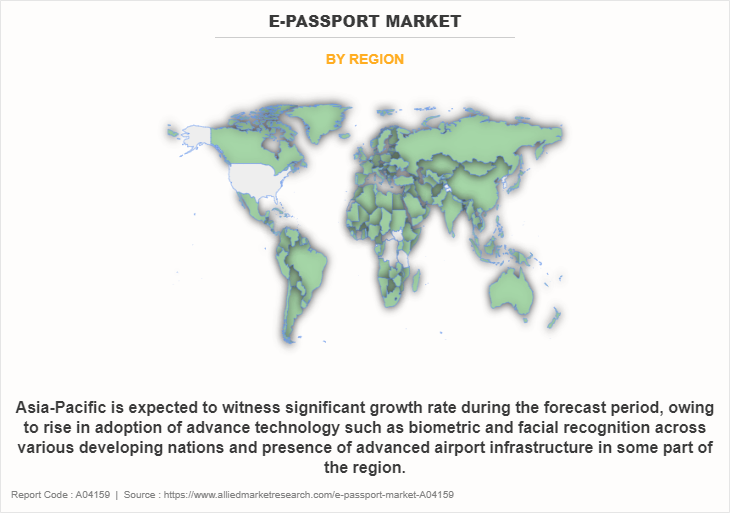E-passport Market Insights, 2032
The global e-passport market was valued at USD 28.8 billion in 2022, and is projected to reach USD 256.2 billion by 2032, growing at a CAGR of 24.8% from 2023 to 2032.
An e-passport is an electronic chip that is printed on passport's page, which contains different types of information such as holder's name, date of birth, and other characteristic information. In addition, this technology stores passenger data on a smart chip, which has a unique identification number and digital signature. Furthermore, many European countries are adopting e-passport as it is safer than traditional paper technology and reduces risk of data duplication and alteration.

Rise in advanced verification technology to detect identity frauds and presence of advanced airport infrastructure among developing nations are some the important factors that propel the market across the globe. In addition, increase in number of people traveling to cross-border destinations propels the global e-passport market growth. However, high implementation cost restrict growth of the market. On the contrary, increase in adoption of wireless communication technology among the travel industry is expected to offer remunerative opportunities for expansion of the global market during the forecast period.
Segment Review
The e-passport market is segmented into Technology and Application. The global is segmented into technology, application, and region. In terms of technology, the market is fragmented into radio frequency identification (RFID) and biometric. Depending on application, it is divided into leisure travel and business travel. Region wise, it is analyzed across North America, Europe, Asia-Pacific, and LAMEA.

The radio frequency identification (RFID) segment dominated the e-passport industry in 2022, owing to increase in deployment of RFID chip that enabled e-passport services among developing nations such as China, Japan, and India. However, biometric segment is expected to grow at a significant CAGR during the forecast period, owing to reduction in threat of identity frauds and increase in need to improve security of personal information of travelers.

Region wise the e passport market analysis, the market share was dominated by Europe in 2022, and is expected to retain its position during the forecast period. This is attributed to presence of advance airport infrastructure in the UK and Germany and rise in use of smartphones during travelling. However, Asia-Pacific is expected to witness a significant growth rate during the forecast period, owing to increase in demand among developing nations, rise in favorable government policies regarding e-passport across the region, and introduction of e-passport smart gates at airports across various developing countries.
Key Market Players
The key players operating in the global e-passport industry include 3M, 4G Identity Solutions, LLC, CardLogix Corporation, Eastcompeace Technology Co., Ltd., Entrust Corporation, HID Global Corporation, Infineon Technologies AG, Muhlbauer Group, Safran, and Thales Group. These players have adopted various strategies to increase their market penetration and strengthen their foothold in the industry.
Key Findings of the Study
Key Benefits
E-passport industry offer a high level of security and are equipped with advanced features, such as biometric authentication, digital signatures, and encryption, which make them much harder to forge or tamper with. This has made E-passports a preferred choice for governments worldwide as they provide a more secure and reliable way of verifying a traveler's identity. E-passports allow for more efficient and streamlined border control procedures, reducing wait times and enhancing the overall travel experience for passengers.
Moreover, they enable seamless integration with other government systems and databases, such as immigration and law enforcement, providing real-time access to crucial information that can help prevent security breaches and facilitate border management. With the rise of international terrorism and organized crime, governments and international organizations have been seeking new ways to enhance security measures and prevent fraudulent activities that drive growth in increasing security concerns. As many countries continue to invest in advanced security technologies and upgrade their border control systems, the demand for E-passports in the global e-passport market size is expected to grow during the forecast period.
End-User Adoption
October 2021: Rocket Mortgage, part of Rocket Companies formed a partnership with Salesforce, an American cloud-based software company. Under this partnership, the company aimed to provide mortgage origination technology to credit unions, banks, and other financial institutions through the financial services cloud of Salesforce. Rocket Mortgage along with Salesforce enabled credit unions and banks to offer personalized and fast customer experiences all through the complete loan process.
November 2022: Ally Bank introduced Ally Everyday Cash Back Mastercard, Ally Platinum Mastercard, and Ally Unlimited Cash Back Mastercard, three cards accessible by invitation only. Ally Everyday Cash Back Mastercard is a spending card that can be used with rewards, Ally Unlimited Cash Back Mastercard provides a flat 2% rate of cash back on all purchases, and Ally Platinum Mastercard enhances the credit and offers a higher line of credit, so the users will appreciate the automatic credit line reviews of the card.
December 2021: Ally Financial acquired Fair Square Financial, a company that provides digital-first credit cards. With this acquisition, the company aimed to enhance its range of consumer products. The acquisition also supported the company's target of being the leading full-service digital bank by incorporating the credit risk improvement and targeting services of Fair Square.
Top Impacting Factors
Rise in Advanced Verification means to Detect Identity Frauds
Companies manufacturing e-passport have added a range of additional electronic and visual security features to fight identity fraud and to increase security of personal information of travelers, which enhances growth of the market. In addition, increase in introduction of microprocessor-based passports and rapid adoption of advance microprocessor-based passport services across developed nations to increase convenience of travelers drives growth of the market. For instance, in January 2022, the Ministry of External Affairs launched microchip-based electronic passports for its citizens. The main features of the new system include the use of biometrics and artificial intelligence in passport relay services, to ensure smooth movement of citizens at all immigration posts globally. Moreover, integration of advance technology such as machine learning and artificial intelligence in e-passport have improved speed of detecting fraudulent cases in documents of travelers, which drives the e-passport market across the globe.
Presence of Advanced Airport Infrastructure
Increase in investments by governments and private organizations to develop advance airport infrastructure across developing nations of Asia-Pacific and LAMEA countries drives growth of the market. In addition, various countries across the globe are deploying advance technologies such as biometric passport technology, geographic information system, and facial recognition technology to identify frauds and threats at airports. Furthermore, several airport development companies have been using digital technologies to improve operational performance and efficiency at airports. For instance, TAV Technologies, one of the leading management technology providers to airline industries have been using IoT technology to collect biometric data of all passengers from simple sensor devices, smartphones, and wearable connected devices. Thus, such developments across developing as well as developed nations drives growth of the market.
Restraints
High Implementation Cost
Innovative e-passport technology is manufactured with highly configurable data management tools, which facilitates validation, recording, updating, retrieval, certifying, and issuance of documents to citizens. This is attributed to increase in implementation cost of e-passport technology. In addition, presence of limited number of e-passport provider companies across Asia-Pacific and high cost of electronic chips and biometric sensors across the region hampers growth of the market of in this region. Furthermore, several e-passport providers have been manufacturing e-passport technology with advanced magnetic tape cards, which increases overall cost of e-passports, which, in turn, hampers growth of the market.
Opportunities
Increase in Development of Wireless Communication Technology
Increase in integration of wireless technologies such as smart card in e-passport, which offers airline industries numerous benefits such as improvement in security of biometric information such as palm scan, iris scan, fingerprints, and digital signature is expected to enhance growth of the market in the future. In addition, radio-frequency identification (RFID) reader and radio-frequency identification (RFID) tag use in e-passport technology to automatically track and identify traveler information such as name, date of birth, age and address provides lucrative opportunities for the market growth. Furthermore, radio frequency signal is integrated in e-passport technology to securely transfer travel information to airline companies, which propels the growth of the e-passport market.
Technological Advancement
Several airport companies have been using advance technologies such as augmented reality, artificial intelligence, and beacons technology to streamline their business process and to improve their revenue. For instance, in November 2022, IDEMIA launched all-new flagship travel document to showcase its most innovative security features and capacity to offer unique yet secure designs, allowing customers to better understand the extent of IDEMIA’s expertise and know-how in the conception, design, and production of innovative passports. Most airports across the UK, Germany, and France have been using blockchain technologies to improve operational efficiencies, security systems, and customer experiences, which provides lucrative opportunities for the market. For instance, Air France, one of the leading airline service providers across France have been using blockchain technology to securely store personal information of travelers such as name, date of birth, age, and address. In addition, biometrics technology is being used at airports to streamline check-in process of customers and to provide a more seamless airport international travelling services, which provides ample opportunities for the market.
Regional Insights:
The market has seen significant growth worldwide due to the increasing need for secure and efficient travel documentation systems. Europe has been at the forefront of e-passport adoption, with countries such as the UK, Germany, and France leading the charge. These nations have fully embraced e-passports as part of their efforts to strengthen border security and streamline immigration processes. The European Union has also implemented stringent regulations to ensure uniformity in e-passport standards across member states, which has contributed to the rapid expansion of the market in this region.
In the Asia-Pacific region, the market is witnessing robust growth, particularly in countries like China, Japan, and India. Governments in this region are increasingly mandating the use of e-passports to meet international travel security standards. India's rollout of its new generation of biometric-enabled e-passports is expected to further drive market growth. Additionally, the growing middle class in Asia-Pacific, coupled with increased international travel, has created a favorable environment for the expansion of the market.
In North America, both the U.S. and Canada are key players in the market. The U.S. has been a leader in the adoption of advanced e-passport technologies, with the Department of State continuously upgrading its passport infrastructure to improve security and enhance the travel experience. Canada, too, has followed suit by issuing e-passports that meet international standards, contributing to the region’s strong market presence.
Key Industry Developments:
July 2023: The U.S. government announced significant upgrades to its e-passport system, incorporating enhanced biometric authentication features, such as facial recognition and fingerprint scanning, to further improve national security and reduce instances of identity fraud.
September 2023: India launched its new-generation e-passports with embedded electronic chips, aiming to improve fraud prevention, and speed up immigration processes. The government set a target for widespread issuance of these e-passports by 2025, with plans to cover both new applicants and renewals.
March 2023: The European Union introduced updated guidelines for e-passports across its member states, mandating advanced encryption standards and biometric data storage to enhance security. The new standards are expected to improve cross-border travel security and streamline customs processes across Europe.
Key Benefits For Stakeholders
This report provides a quantitative analysis of the market segments, current trends, estimations, and dynamics of the E-passport market analysis from 2023 to 2032 to identify the prevailing e-passport market opportunity.
The market research is offered along with information related to key drivers, restraints, and opportunities.
Porter's five forces analysis highlights the potency of buyers and suppliers to enable stakeholders make profit-oriented business decisions and strengthen their supplier-buyer network.
In-depth analysis of the E-passport market segmentation assists to determine the prevailing market outlook.
Major countries in each region are mapped according to their revenue contribution to the global e-passport market forecast.
Market player positioning facilitates benchmarking and provides a clear understanding of the present position of the market players.
The report includes the analysis of the regional as well as global E-passport market trends, key players, market segments, application areas, and market growth strategies.
E-passport Market Report Highlights
| Aspects | Details |
| Market Size By 2032 | USD 256.2 billion |
| Growth Rate | CAGR of 24.8% |
| Forecast period | 2022 - 2032 |
| Report Pages | 210 |
| By Technology |
|
| By Application |
|
| By Region |
|
| Key Market Players | CARDLOGIX CORPORATION, 3M, Thales Group, 4G Identity Solutions, HID Global Corporation, Infineon Technologies AG, SAFRAN, Muhlbauer Group, Eastcompeace Technology Co., Ltd., Entrust Corporation |
Analyst Review
Adoption of e-passport has increased over time, owing to its numerous benefits such as increased accessibility and better user experience for citizen traveling, delivering secure, safe and efficient transportation of travelers, and improving security of citizen’s travel documents. In addition, e-passport provides space in airports for quick processing of passengers and helps existing airport staff to manage more traffic efficiently. Moreover, various airports in developing nations of Asia-Pacific and LAMEA are rapidly adopting e-passport to enhances the quality of document inspection and to improve identify of improper document uses.
The global e-passport market is expected to register high growth, due to rise in demand for better identity verification solutions and increasing requirement for enhanced security features. More number of people are using electronic passports, also known as e-passports or biometric passports, due to their increased security features and capacity for quick and secure border crossing. Thus, increase in adoption of e-passport, owing to its high reliability and low latency networks, is one of the most significant factors driving the growth of the market. With surge in demand for e-passport, various companies have established alliances to increase their capabilities. For instance, in July 2022, Zwipe partnered with International Network for Cards and Digital Payment Services (INC) to pilot biometric payment cards in Iraq. International network for cards (INC) and digital payment services offers the issuance of white label biometrics cards for banks and payment companies. The first client is INC’s own NEO Visa cards, which is expected to be Iraq’s first biometric payment cards, according to the announcement .
In addition, with further growth in investment globally and rise in demand for e-passport, various companies have expanded their current product portfolio with increased diversification among customers. For instance, in May 2021, Juniper Networks launched the MX10008 Universal Routing Platform, a high-performance router designed for data center and service provider networks. The router offers advanced routing, security, and automation features and can handle massive amounts of traffic.
Moreover, with increase in competition, major market players have started acquisition companies to expand their market penetration and reach. For instance, in December 2023, Austriacard acquired Nitecrest to develop biometric payment cards and to flip card issuing on its head and take the helm to delivering the next generation of payment cards.
The E-passport market is estimated to grow at a CAGR of 24.8% from 2023 to 2032.
The E-passport market is projected to reach $ 179,247.42 million by 2032.
Increase in number of people traveling to cross-border destinations propels the growth of the global e-passport market. In addition, rise in advanced verification technology to detect identity frauds and presence of advanced airport infrastructure among developing nations also boost the e-passport market across the globe. However, availability of cost-effective e-passport and high implementation cost restrict growth of the market. Also, increase in adoption of wireless communication technology among the travel industry is expected to offer remunerative opportunities for expansion of the global market during the forecast period.
The key players profiled in the report include 3M, 4G Identity Solutions, LLC, CardLogix Corporation, Eastcompeace Technology Co., Ltd., Entrust Corporation, HID Global Corporation, Infineon Technologies AG, Muhlbauer Group, Safran, and Thales Group.
The key growth strategies of E-passport market players include product portfolio expansion, mergers & acquisitions, agreements, geographical expansion, and collaborations.
Loading Table Of Content...
Loading Research Methodology...



